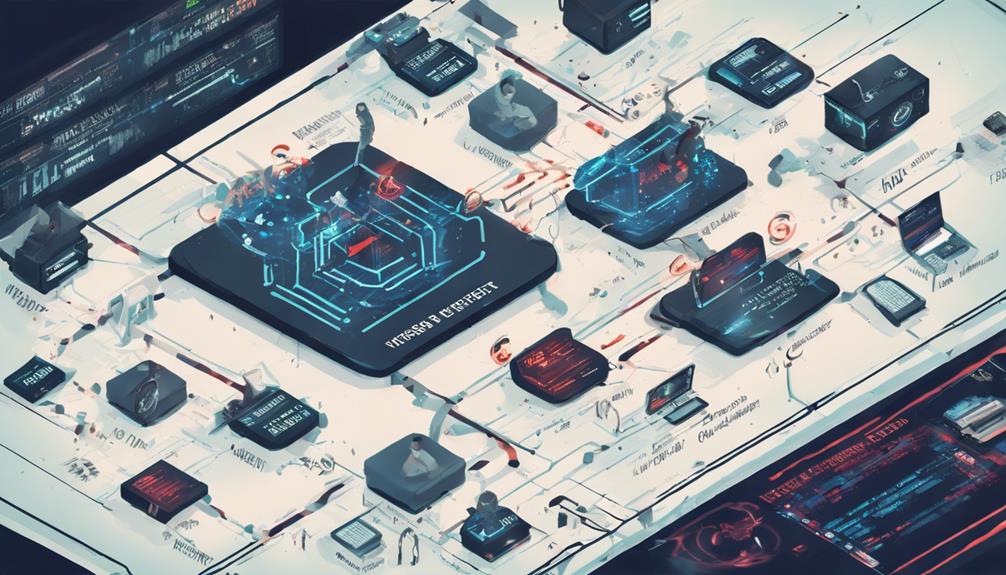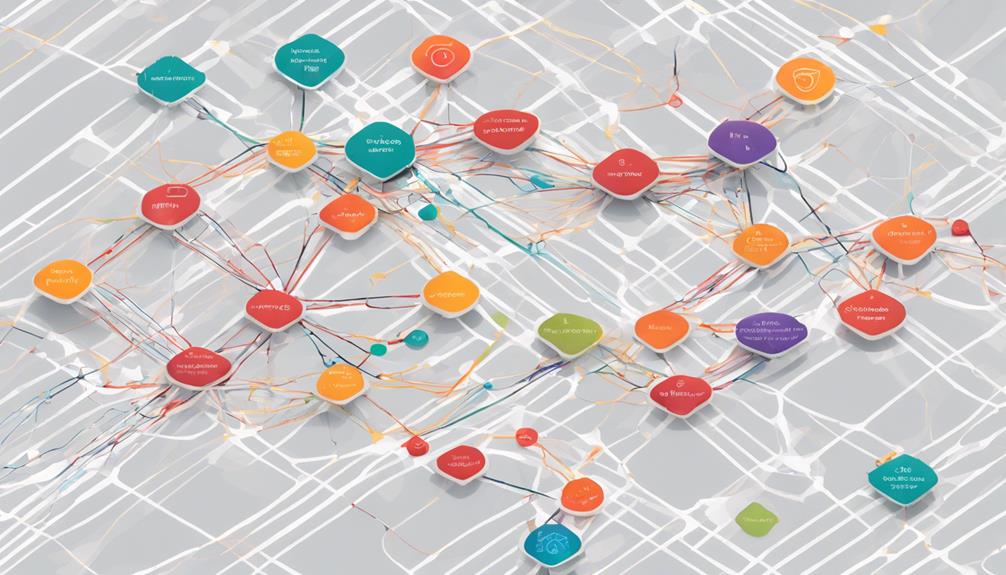Explore innovative cybersecurity AI projects such as AI-Powered Threat Detection utilizing machine learning for robust defense. Implement Machine Learning for Risk Analysis to predict and preempt cyber risks effectively. AI-driven Incident Response Systems streamline threat management with automated responses. Enhance Security Operations Centers with AI tools for real-time analysis and proactive threat mitigation. Adaptive Authentication Solutions guarantee secure user verification and anomaly detection. Embrace cutting-edge Behavioral Analytics for anomaly detection and incident response efficiency. Secure Data Encryption Techniques fortify data protection against cyber threats. Discover more on regulatory compliance automation and advanced cybersecurity practices for a fortified digital defense.
Key Takeaways
- AI-powered threat detection enhances security defenses.
- Machine learning predicts and proactively addresses risks.
- Advanced security techniques include anomaly detection and encryption.
- Automated incident response systems minimize breach impact.
- AI strengthens security operations with real-time analysis.
AI-Powered Threat Detection
AI-Powered Threat Detection plays an essential role in modern cybersecurity defense strategies by utilizing advanced machine learning algorithms to analyze data and identify potential security risks.
These AI-powered systems can analyze vast amounts of data in real-time, using machine learning models to detect anomalies and patterns indicative of cyber threats.
By automating threat detection, organizations can greatly enhance the speed and accuracy of identifying and responding to security incidents.
One key advantage of AI-powered threat detection is the ability of AI models to continuously learn and adapt to evolving cyber threats.
This adaptability improves the overall effectiveness of cybersecurity defenses by staying ahead of sophisticated attacks.
Implementing AI-powered threat detection tools can help organizations protect sensitive data and maintain a proactive stance against cyber threats.
Machine Learning for Risk Analysis

Machine learning plays a vital role in analyzing cybersecurity risks by utilizing advanced algorithms to detect anomalies in network traffic, system behavior, and user activity. These algorithms not only identify potential threats but also predict cybersecurity risks, helping organizations to proactively strengthen their defenses.
Risk Detection Algorithms
Utilizing advanced risk detection algorithms powered by machine learning, organizations can proactively identify and thwart potential cyber threats. These algorithms leverage the capabilities of machine learning to analyze patterns and anomalies in data, enhancing threat detection accuracy.
Here are key points on the significance of risk detection algorithms in bolstering cybersecurity posture:
- Critical Threat Identification: Risk detection algorithms excel in spotting potential cyber threats like malware, phishing attacks, and unauthorized access attempts swiftly and accurately.
- Continuous Learning: Machine learning models used in risk analysis continuously learn from new data, improving threat detection capabilities and adapting to the dynamic cybersecurity landscape.
- Proactive Risk Mitigation: By integrating AI-driven risk detection algorithms, organizations can preemptively identify and address security risks before they escalate into significant incidents, ultimately fortifying their cybersecurity posture and response efficiency.
Incorporating machine learning for risk analysis ensures automated, real-time monitoring of security events, which is essential for maintaining a robust cybersecurity posture in today's digital landscape.
Threat Prediction Models
Risk prediction models leverage machine learning algorithms to analyze historical data and patterns for anticipating cybersecurity threats. These AI models play a vital role in enhancing security measures by identifying potential risks and vulnerabilities in real-time. By continuously learning from new data, these models can adapt to evolving cyber threats, providing accurate risk assessments to prevent security breaches effectively.
Here is a table summarizing key aspects of threat prediction models:
| Key Aspect | Description | Importance |
|---|---|---|
| Real-time Detection | Identifying threats as they occur enables proactive responses. | High |
| Anomaly Detection | Detecting unusual activities that may indicate a cyber attack. | Critical |
| Adaptability | Ability to learn from new data and evolve to counter emerging threats. | Essential |
| Accuracy | Providing precise risk assessments to prevent security breaches effectively. | Vital |
| Ethical Guidelines | Ensuring the use of AI models aligns with ethical standards in cybersecurity. | Fundamental |
Considering the importance of these aspects and adherence to ethical guidelines, implementing threat prediction models can significantly enhance an organization's cybersecurity posture.
Anomaly Detection Techniques
Anomaly detection techniques in cybersecurity AI projects leverage advanced machine learning algorithms to identify irregular patterns or behaviors within data. These techniques play a pivotal role in risk analysis by detecting potential security breaches, fraudulent activities, or abnormal occurrences within a system.
Key points regarding anomaly detection techniques in cybersecurity AI projects include:
- Machine learning algorithms like neural networks, support vector machines, and clustering methods are commonly employed to detect anomalies effectively.
- By analyzing historical data and establishing normal behavior patterns, AI systems can swiftly identify deviations that may signal security threats.
- The implementation of anomaly detection techniques fortifies cybersecurity defenses by facilitating proactive monitoring and real-time threat detection, thereby enhancing overall system security.
Through the integration of these sophisticated machine learning algorithms, cybersecurity AI projects can enhance their ability to detect and mitigate potential risks, ensuring a more secure digital environment.
Automated Incident Response Systems

Automated Incident Response Systems leverage AI technology to swiftly identify and neutralize cybersecurity threats as they arise.
By automating the detection and response process, organizations can enhance their security posture and minimize the impact of potential breaches.
Through the use of AI-driven systems, companies can achieve greater efficiency in threat management, allowing for proactive measures to be taken promptly.
AI in Incident Response
Utilizing advanced AI algorithms, Incident Response systems leverage real-time detection and response capabilities in cybersecurity operations. AI in cybersecurity has revolutionized incident response by introducing automated systems that enhance security measures.
Here are key aspects highlighting the significance of AI in Incident Response:
- Efficient Threat Detection: Automated incident response systems can swiftly analyze vast amounts of data, enabling the identification of potential threats and vulnerabilities in real-time. This proactive approach helps in mitigating risks before they escalate.
- Streamlined Incident Handling: By automating repetitive tasks such as data analysis and initial response actions, AI systems enable security analysts to focus on complex threats and strategic decision-making. This streamlining of processes reduces response times and minimizes the impact of cybersecurity incidents.
- Enhanced Cybersecurity Posture: The integration of AI in Incident Response not only improves response efficiency but also strengthens overall cybersecurity posture by facilitating proactive threat detection and response strategies. This proactive stance is essential in combating evolving cyber threats effectively.
Threat Detection Automation
AI-powered systems for automated incident response play a pivotal role in enhancing cybersecurity defenses by rapidly detecting and responding to potential threats in real-time. These AI systems employ sophisticated algorithms to sift through vast amounts of data, pinpointing patterns and anomalies that could signify security breaches.
By automating incident response, organizations can greatly reduce response times, swiftly mitigating the impact of cyber attacks. Continuous monitoring for security threats using AI-driven tools further bolsters the overall cybersecurity posture of a system.
Implementing Automated Incident Response Systems not only enhances security but also improves efficiency and accuracy in responding to security incidents. These systems act as proactive guardians, tirelessly scanning and analyzing for any signs of security threats, providing a robust layer of defense in the digital domain.
In today's dynamic threat landscape, leveraging AI for automated incident response is a strategic move towards fortifying cybersecurity defenses.
Efficiency Through AI
Enhancing operational efficiency through the integration of advanced incident response systems driven by artificial intelligence technology is paramount in modern cybersecurity strategies. AI applications in incident response offer a range of benefits, including:
- Reduced Response Time: Automated incident response systems powered by AI can decrease the time to address cyber threats by up to 65%, enabling organizations to react swiftly to potential breaches.
- Real-Time Analysis: These AI-driven systems have the capability to analyze large volumes of security data in real-time, facilitating quick detection and response to cyber attacks before they escalate.
- Enhanced Security Posture: By automating routine tasks and prioritizing alerts, AI incident response tools help organizations allocate resources efficiently, strengthening their overall security posture and data protection measures.
Implementing AI technologies in incident response not only streamlines processes but also empowers cybersecurity professionals to address more complex security issues, ultimately fortifying an organization's resilience against evolving threats.
Enhancing Security Operations Centers

Security Operations Centers leverage advanced artificial intelligence technologies to bolster their capabilities in detecting and responding to cyber threats. By integrating AI tools, SOCs can enhance their cyber defense mechanisms through real-time analysis of vast amounts of data. Machine learning algorithms play an essential role in improving detection accuracy and reducing response times to potential security breaches. These AI-powered SOCs enable proactive threat hunting and mitigation strategies, thereby fortifying the organization's cybersecurity posture.
The incorporation of artificial intelligence in SOCs not only enhances threat detection but also elevates overall security operations efficiency and effectiveness. With AI-driven systems in place, security teams can swiftly identify anomalies, predict potential threats, and take preemptive actions to safeguard the organization's digital assets. This blend of human expertise with machine intelligence equips SOCs with the necessary tools to combat evolving cyber threats effectively, ensuring a robust defense mechanism against sophisticated adversaries.
Adaptive Authentication Solutions

In the field of cybersecurity technology, adaptive authentication solutions revolutionize user verification processes by leveraging AI algorithms to dynamically adjust security measures based on behavioral patterns and risk assessments. These AI-driven adaptive authentication systems offer a proactive approach to cybersecurity defenses, enhancing user security through real-time analysis of user behavior.
Here are key points highlighting the importance of adaptive authentication solutions:
- Essential Security Measures: By analyzing patterns, locations, devices, and other user behavior factors, adaptive authentication solutions verify user identity more accurately, reducing the risk of unauthorized access.
- Anomaly Detection: AI-driven adaptive authentication can detect anomalies and potential threats in real-time, providing organizations with advanced warning to prevent security breaches.
- Improved User Experience: Organizations benefit from reduced false positives and improved user experience with adaptive authentication technologies, ensuring a seamless and secure authentication process.
These continuous monitoring and learning capabilities strengthen cybersecurity defenses against evolving threats, making adaptive authentication solutions an essential component of a robust cybersecurity strategy.
Behavioral Analytics for Anomaly Detection

Utilizing advanced artificial intelligence algorithms, behavioral analytics for anomaly detection plays an essential role in fortifying cybersecurity defenses by identifying deviations from typical user behavior patterns. By leveraging AI algorithms, this approach can effectively detect anomalous activities that may signify insider threats, advanced persistent threats, or other malicious behaviors.
The continuous learning capability of AI algorithms in behavioral analytics allows for improved detection accuracy over time, adapting to evolving cybersecurity threats.
Monitoring user activities in real-time enables organizations to proactively respond to potential security breaches by swiftly identifying behavior-based indicators of compromise. This proactive stance minimizes false positives and enhances incident response efficiency, focusing on the most critical threats.
Secure Data Encryption Techniques

Secure data encryption techniques play a pivotal role in safeguarding sensitive information within AI projects. When implementing encryption strategies, consider the following key aspects:
- Encryption Keys: Encryption keys are fundamental in securing data by allowing only authorized parties to decrypt it. Managing and protecting these keys is essential to maintaining the integrity of the encryption process.
- Advanced Encryption Standards: Utilizing advanced encryption standards such as SHA-256 and AES-256 enhances the security of AI systems against unauthorized access. These robust encryption algorithms provide a high level of protection for sensitive data.
- End-to-End Encryption: Implementing end-to-end encryption methodologies ensures that data remains secure during transmission and storage within AI systems. This thorough approach to encryption minimizes the risk of interception or tampering, safeguarding critical information effectively.
Regulatory Compliance Automation

Data encryption techniques are essential for safeguarding sensitive information within AI projects, and regulatory compliance automation further enhances security measures by utilizing AI algorithms to guarantee adherence to industry regulations like GDPR.
In cybersecurity AI projects, regulatory compliance automation plays a pivotal role in ensuring that organizations meet the necessary standards set by regulatory bodies. By automating compliance checks through AI algorithms, potential violations can be identified and addressed with increased efficiency and accuracy. This not only helps in reducing human error but also streamlines the auditing process for companies, leading to enhanced overall security posture.
Automated compliance tools continuously monitor AI systems to ensure they adhere to industry regulations, thereby minimizing legal risks and maintaining data protection. Implementing regulatory compliance automation is essential for organizations looking to stay compliant with evolving industry regulations while leveraging the capabilities of AI technology to enhance cybersecurity measures.
Frequently Asked Questions
What Are Some Examples of AI in Cyber Security?
In cybersecurity, AI is utilized for anomaly detection in network traffic, predictive analysis of security breaches, autonomous threat response with intrusion detection systems, identification of insider threats through behavioral analytics, and proactive threat monitoring with AI-driven intelligence platforms.
How Can AI Be Implemented in Cyber Security?
In the field of cybersecurity, AI serves as a vigilant sentinel, fortifying defenses through threat detection, anomaly analysis, and automated response mechanisms. By leveraging machine learning algorithms and deep learning models, AI bolsters security operations with enhanced efficiency and accuracy.
How Is Cybersecurity AI Being Improved?
Cybersecurity AI is enhanced through algorithm and model updates to address vulnerabilities, adherence to data protection regulations like GDPR, robust access controls, authentication mechanisms, security audits, adversarial testing, and transparency in AI models to identify biases and vulnerabilities.
How Are AI Systems Typically Used in the Cyber Security Industry?
AI systems are instrumental in cyber security for threat detection, anomaly identification, and automation of tasks like log analysis. By leveraging machine learning and deep learning algorithms, these systems can enhance security monitoring, detect malicious activities, and predict vulnerabilities to fortify defense mechanisms.
Conclusion
In summary, the implementation of cybersecurity AI projects is essential in today's digital landscape.
By leveraging AI-powered threat detection, machine learning for risk analysis, and automated incident response systems, organizations can enhance their security operations and protect sensitive data.
Behavioral analytics, secure encryption techniques, and regulatory compliance automation further strengthen defenses against cyber threats.
Embracing these innovations and best practices will guarantee a proactive approach to cybersecurity, safeguarding against potential breaches and maintaining data integrity.
Remember, in the world of cybersecurity, prevention is always better than cure.









